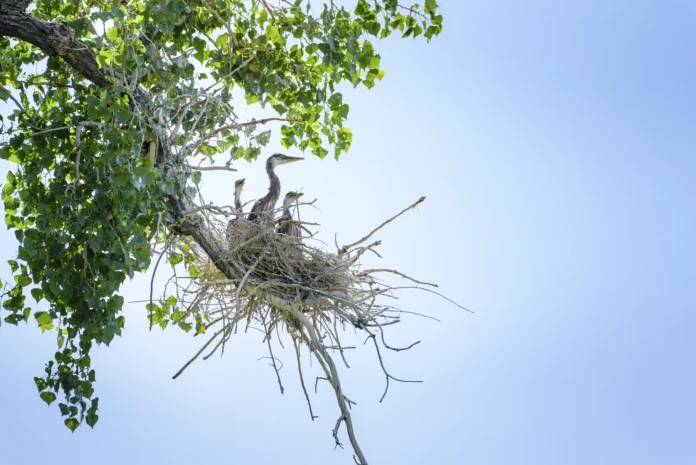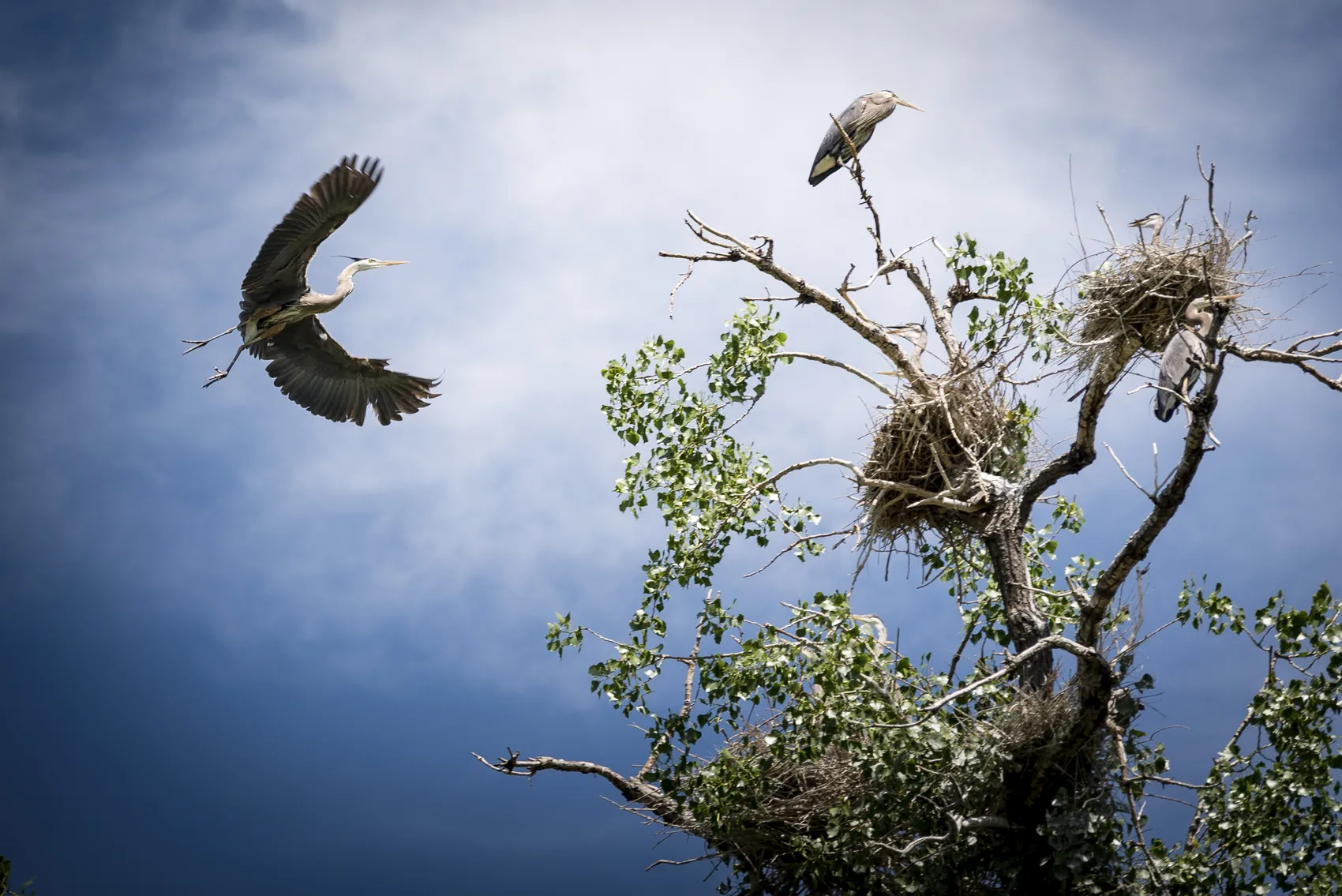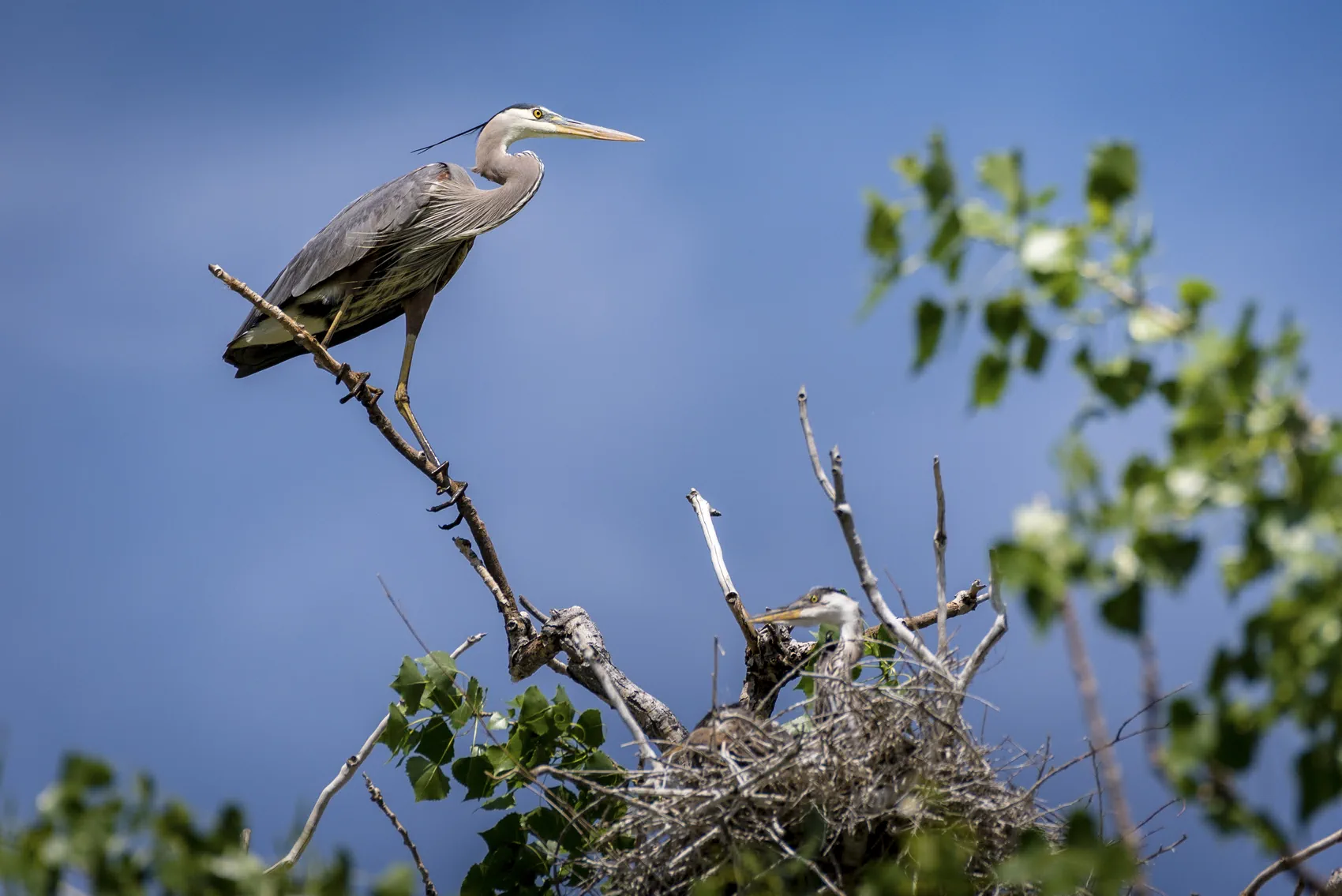The day I found the rookery was warm and still, one of those late-summer afternoons when the lake west of Fort Collins looked like glass. I’d been wandering with my camera near a plant nursery south of Harmony Road, following a faint game trail through willows and cottonwoods. I expected dragonflies, maybe a single heron hunting along the shallows. What I didn’t expect was the noise — a dry, prehistoric clatter echoing through the treetops. I stopped, scanned upward, and there it was: a massive cottonwood alive with life. Roughly twenty-five stick nests crowned its highest forks. Great Blue Herons had turned this single tree into a city in the sky.
We think of Great Blue Herons (Ardea herodias) as solitary — one bird standing still and alone on a sandbar. But when it’s time to raise young, they gather. These gatherings are called rookeries, and on Colorado’s Front Range they form wherever water, fish, and old cottonwoods still exist. What I stumbled upon that day wasn’t an accident; it was the result of generations of birds returning to a site that works.
How They Arrive and Claim the Trees
Herons that nest around Fort Collins are mostly migratory. Many spend the winter far south — along the Gulf Coast, Mexico, or ice-free reservoirs in the Southwest — then follow thawing rivers and lengthening days back north. Some hardy birds winter locally if lakes or rivers stay open, but most return between late February and mid-March.
Adults are loyal to productive sites. If the cottonwood and nearby water keep working, the same seasoned breeders reclaim the same nests year after year. Males arrive first, refurbishing old platforms or starting new ones. They present sticks to potential mates, point their long bills skyward in dramatic courtship, and even steal building material from neighbors when they think they can get away with it. The cottonwood groans under the weight and the chaos, but it’s built for this. The colony comes alive almost overnight.
Nesting and Raising Young
Eggs usually appear by early April, pale blue and two to four per clutch. Both parents share incubation for about a month. By late April or early May, chicks hatch — small, gray, and noisy. From the ground, you often hear them before you see them: raspy begging calls whenever a parent lands.
Food runs dominate the day. Herons commute between the rookery and nearby ponds, rivers, and irrigation ditches, spearing whatever prey is available: suckers, trout, minnows, sunfish, crayfish, frogs, snakes, even the occasional meadow vole. They’re generalist hunters with a specialist’s patience, using perfect geometry and slow motion to strike.
Spring storms are the colony’s greatest natural threat. Wet snow and high winds can snap branches or flood nests. Great Horned Owls and raccoons raid when they can reach eggs or chicks. But most years, the majority of nests succeed if the site remains undisturbed.
The Quiet Fledging and Dispersal
By mid-June, chicks are gangly and nearly full-sized, practicing flight at the nest rim. First flights usually happen in late June through mid-July. Soon the cottonwood fills with awkward landings and short, nervous hops.
By August — the day I first walked under this tree — the rookery was thinning. Young birds were venturing out to hunt on their own, while adults began to disperse. Some herons linger in northern Colorado’s lakes and reservoirs into autumn. Others drift south with the shortening days, following the South Platte and Arkansas or dropping into New Mexico, Texas, and Gulf wetlands. Migration isn’t one grand, synchronized flight — it’s a quiet spreading toward reliable food and open water.
When late winter comes, many of these same adults will return to this exact tree if the habitat hasn’t changed.
The Hidden Pressures They Face
Finding this thriving rookery felt like discovering a hidden success story. But standing there also made me think about the quiet forces that could undo it.
Agriculture and Water Management
Northern Colorado is built on farming. Irrigation canals cut through nearly every valley, and water rights are stretched thin. Herons rely on shallow wetlands, oxbows, and side channels for small fish and amphibians. When ditches drain too early or lakes are drawn down for irrigation, prey can vanish just when chicks need the most food. Pesticides and herbicides from fields can reduce the frogs and invertebrates herons eat, or move up the food chain in fish.
Manure and fertilizer runoff can trigger algae blooms and low oxygen in ponds, reducing fish populations. Some irrigation structures strand fish, turning a once-productive ditch into an empty one overnight. Herons adapt well, but they need water bodies alive with prey — not sterile ditches or ponds gone hypoxic.
Habitat Loss
Rookeries need big, old cottonwoods. Development — subdivisions, commercial pads, or even clearing for safety — removes them. Sometimes a single tree holds decades of colony history; if it’s cut or blown down, the birds have nowhere nearby to go. Herons are sensitive to disturbance. If a new trail or boat launch pushes too close, an entire rookery can fail in one season. The tree I found is surrounded by private land and a nursery — quiet enough now, but any change could disrupt it.
Climate Change
The Front Range is already feeling the push of climate change: hotter summers, longer droughts, more intense spring storms. Each trend touches herons.
- Heat and drought can shrink shallow feeding areas and concentrate pollutants.
- Erratic runoff from early snowmelt or heavy rain can make rivers too turbid for fishing just when parents need clear water.
- Powerful spring storms — fueled by warmer, wetter air — can rip nests apart during incubation or kill chicks with cold and wet.
Great Blue Herons are adaptable, but they rely on a chain of working habitats. Break too many links — with heat, drought, or flooded nests — and recruitment drops.
Contaminants
While less obvious than decades past, heavy metals and pesticides still reach wetlands. Mercury accumulates in fish; so do legacy chemicals. Chicks fed contaminated prey can suffer reduced survival and impaired growth. Newer compounds, like some herbicides and PFAS chemicals, are emerging concerns for fish-eating birds.
Photographing With Respect
I know how easy it is to want the perfect frame — the chick stretching its wings, the adult mid-strike with a fish. But these birds will abandon if disturbed too often during nesting. That warm day, I stayed well back on the lakeshore, using a long lens and watching body language. If adults stared too long or raised head feathers, I backed away.
Photography can help conservation when it’s done ethically. A single season of patient images shows the colony’s size and health. If the tree falls or the site is lost, those photographs become a record — proof of what was here.
Why It Matters to Keep Places Like This
The Front Range is booming. New houses, new roads, and thirsty farms all compete for the same water and land that keep these herons alive. A rookery isn’t just a bunch of birds — it’s a sign that the local river and wetland network still works. If a single big cottonwood and its neighbors can hold dozens of nests, the ecosystem is still functioning in spite of us.
Losing rookeries would mean more than losing a photo opportunity. Herons are apex wetland hunters; their presence means fish, amphibians, and invertebrates are still thriving below the surface. Protecting them protects a whole web of life.
The fixes aren’t complicated:
- Leave old cottonwoods standing whenever possible.
- Keep a respectful buffer from rookeries March–July.
- Support wetland and riparian restoration projects that keep small fish and frogs plentiful.
- Encourage water management that leaves some shallow, slow areas for wildlife during irrigation season.
Returning Each Year
I plan to go back next February, boots crunching on frozen ground, hoping to hear that first rasping croak that says the colony survived another winter. I’ll watch as the first males arrive, see nests patched and courtship dances begin, and document the new season’s story.
There’s a deep satisfaction in seeing a wild tradition continue — birds returning not out of nostalgia but because the habitat still functions. My job as a photographer is to witness and share that truth, and maybe convince a few more people that these old cottonwoods and quiet wetlands are worth leaving alone.
That warm late-summer day west of Fort Collins, I stumbled into something ancient and fragile — a city of Great Blue Herons thriving above our busy lives. Their future depends on choices we make about water, land, and climate. For now, the rookery stands, and the herons will come back as long as we let them.
References and research
- Ecology of the Great Blue Heron (Ardea herodias) rookery on the Slate River, Crested Butte, Colorado and impacts of human activities — Magee & Zareba, 2018
- A local great blue heronry provides a natural spectacle — University of Colorado, 2021
- Protecting a vulnerable great blue heron rookery — High Country News
- Great Blue Herons — City and County of Broomfield (official)
- What happened to the heron tree near Interstate 25 — Coloradoan, 2023







